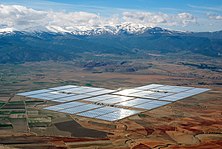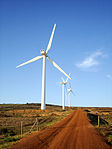低碳经济
低碳经济(英语:low-carbon economy,简称LCE)是种达到温室气体净零排放程度的经济。[2]人类活动引起的温室气体排放是造成自20世纪中叶以来观测到的气候变化的主要原因。[3]转向低碳经济有许多行之有效的方法,例如鼓励能源转型、节约能源、交通电气化(如使用电动载具)以及进行碳捕集与封存。零碳城市即是体现低碳经济中的一例。
定义与专有名词
编辑论及低碳经济概念,以下是一些常用同义字或相近词汇,每个词汇都强调概念的不同面向:
绿色经济、永续经济、净零排放经济、低排放经济、气候友善型经济及脱碳经济。
低碳经济中"碳"一字是所有温室气体的通称。
英国国家统计局在2017年发布的定义是: "低碳经济的定义是提供商品和服务的经济活动,活动中的温室气体(主要为二氧化碳)排放量会显著低于以往的。 "[5]:2
基本原理与目标
编辑人类活动造成的温室气体排放是自20世纪中叶以来观测到的气候变化主要原因。长期持续排放温室气体将在世界各地造成变化,会对人类和生态系统造成严重、普遍和不可逆转的影响。[3]
各国会寻求成为低碳或脱碳经济体,以达成气候变化缓解的目的。要缓解气候变化,就要走上净零排放的途径。[6]
方法
编辑实现低碳经济涉及减少能源、交通、工业和农业等部门的温室气体排放。文献常谈到从高碳经济转换为低碳经济。这种转变应该以公正方式进行(称为公正转型)。[7]:75
转向低碳经济的策略和方法很多,例如鼓励往再生能源转型、追求能源效率、节约能源、交通电气化、实施碳捕获与封存、从事气候智慧型农业。为达到目的,需要采取适当的能源政策、财政激励措施(例如开放排放权交易、征收碳税)、实践应对气候变化的个人行动及应对气候变化的企业行动。
各国所采的行动
编辑在国际舞台上,进行低碳经济最突出的早期步骤是于1997年签署,并于2005年生效的《京都议定书》,参与的大多数工业化国家均承诺减少碳排放。[8][9]
经合组织(OECD)国家间可相互学习并效法某些国家在特定领域的范例:瑞士的能源部门(参见瑞士能源)、英国的工业部门、荷兰的运输部门(参见荷兰交通)、韩国的农业部门(参见韩国农业)以及瑞典的建筑部门。[10]
共同效益
编辑向低碳经济转型的主要好处是它有助于缓解气候变化。此外还有其他共同效益:对生态系统韧性、[11]贸易、就业、健康、能源安全和工业竞争力带来多重好处。[12][13]
于绿色转型期间,在排放强度高的产业中从业者更有可能会失业。向净零排放经济转型,将会导致密布排放强度高的产业地区丧失更多就业机会。[14][15][16]绿色转型所带来的就业机会与再生能源,或改善和翻新基础设施相关的活动有关。[17]
排放强度低的产业发展和增进资源效率可为提高经济体和公司竞争力提供许多机会。根据倡议机制低排放发展策略全球合作伙伴(简称LEDS GP,有世界资源研究所及联合国等机构涉入)的说法,利用金融投资,转向低排放技术通常有明确的商业案例,投资回收期大多数可在0.5-5年之间达成。[18]
能源面
编辑低碳电力
编辑本节摘自低碳电力。
低碳电力(英语:Low-carbon electricity,或以英语:low-carbon power表达)指的是在整个生命周期内温室气体排放量远低于使用化石燃料所产生的电力。[19]能源转型途中使用低碳电力是实现气候变化缓解最重要行动之一。[20]
低碳发电能源包含有风能、太阳能、核能和大部分的水力。[21][22]这个名词很大程度上将传统的化石燃料发电厂生产的电力排除在外,但会用于描述目前运行中化石燃料发电系统的特定领域,特别是那些配置有从烟道气中将碳捕集与封存的系统。 [23]全球于2020年中有近40%的电力来自低碳能源:约10%为核能发电,近10%为风能和太阳能发电,约20%为水力和其他再生能源发电。[20]
核能发电
编辑截至2021年,扩张运用核能作为实现低碳经济的方式得到不同程度的支持。[24]包括联合国欧洲经济委员会、[25]国际能源署 (IEA)、[26]国际原子能总署、[27]和美国研究机构能源影响中心(EIC)等组织均认为如果不扩大核能发电规模,就不可能实现全球脱碳 。 [28]IEA和EIC都认为全球到2040年必须实现广泛的脱碳,以降低气候变化的不利影响,而必须利用核能发电以发挥作用。EIC建议使用核能产生的电力作为碳捕集技术的燃料,以实现净负碳排放。[28][29]
能源转型
编辑能源转型(英语:Energy transition,也称为能源体系转型,英语:Energy system transformation),指的是能源体系中的供给和消费发生的重大结构性变化。目前全球为限制气候变化,正转向使用永续能源。由于许多永续能源都是再生能源,因此也称为再生能源转型 (英语:renewable energy transition)。目前的转型的目的在能快速、可持续地减少使用能源时产生温室气体排放,主要是透过逐步减少使用化石燃料,并尽可能多用低碳电力[31]。先前的能源转型发生在1760年开始的第一次工业革命出现蒸汽机后,所用能源从燃烧木材(柴火和木炭)和其它生物质(比如油脂和干粪)转换为燃烧煤碳,接著在19世纪末的第二次工业革命出现内燃机后改为燃烧石油和天然气[32][33]。
目前世界上四分之三以上的能源是透过燃烧化石燃料而来,但会因此排放温室气体。[34]能源生产和消耗是导致当前大部分人为温室气体排放的原因。[35]为实现2015年《巴黎协议》中设定的目标,全球必须尽快减少温室气体排放,并在本世纪中叶实现净零排放。[36]自2010年代末以来,由于太阳能和风能发电成本迅速下降,得以推动再生能源转型。[37]能源转型的另一目标是减少此产业对健康和环境的负面影响(参见能源产业对环境的影响)。[38]这类影响不仅涉及气候变化,还涉及毒性排放物、资源利用、空气污染造成的健康问题等。[38]:49
目前为建筑物进行暖通空调已朝电气化的方向前进,热泵是迄今为止最有效的技术。[39]为提高电网的灵活性,安装储能和架设超级电网对于利用间歇性、依赖天气的技术尤其重要。[40]然而各国施行的化石燃料补贴会将能源转型的步调减缓。[41][42]实现低碳经济的影响
编辑于2019年由加州大学发表名为(能源转型后的地缘政治收益与损失:评估地缘政治在气候变化缓解后变动的新颖指标(Geopolitical Gains and Losses after Energy Transition: A Novel Index for Assessing the Geopolitical Impacts of Climate Change Mitigation))(简称GeGaLo index)的文章中评估,如果世界完全转向再生能源,全球156个国家的地缘政治地位可能会发生变化。预计前化石燃料出口国将会丧失影响力,而前化石燃料进口国和再生能源资源丰富的国家的地位预计将会受到强化。[43]
参见
编辑参考文献
编辑- ^ Electricity production by source, World. Our World in Data, crediting Ember. (原始内容存档于2023-10-02). OWID credits "Source: Ember's Yearly Electricity Data; Ember's European Electricity Review; Energy Institute Statistical Review of World Energy".
- ^ Three steps to a low-carbon economy: THE GOAL OF ZERO NET EMISSIONS CAN BE ACHIEVED (PDF).
- ^ 3.0 3.1 IPCC, 2014: Climate Change 2014: Synthesis Report. Contribution of Working Groups I, II and III to the Fifth Assessment Report of the Intergovernmental Panel on Climate Change. Core Writing Team, R.K. Pachauri and L.A. Meyer (eds.) (PDF). Intergovernmental Panel on Climate Change. [2016-03-22]. (原始内容存档 (PDF)于2018-11-23).
- ^ Koh, Jae Myong (2018). Green Infrastructure Financing: Institutional Investors, PPPs and Bankable Projects. London: Palgrave Macmillan. ISBN 978-3-319-71769-2.
- ^ Low carbon and renewable energy economy, UK - Office for National Statistics. www.ons.gov.uk. [2024-01-17].
- ^ Chen, Lin; Msigwa, Goodluck; Yang, Mingyu; Osman, Ahmed I.; Fawzy, Samer; Rooney, David W.; Yap, Pow-Seng. Strategies to achieve a carbon neutral society: a review. Environmental Chemistry Letters. 2022, 20 (4): 2277–2310. Bibcode:2022EnvCL..20.2277C. PMC 8992416 . PMID 35431715. doi:10.1007/s10311-022-01435-8 .
- ^ M. Pathak, R. Slade, P.R. Shukla, J. Skea, R. Pichs-Madruga, D. Ürge-Vorsatz,2022: Technical Summary. In: Climate Change 2022: Mitigation of Climate Change. Contribution of Working Group III to the Sixth Assessment Report of the Intergovernmental Panel on Climate Change [P.R. Shukla, J. Skea, R. Slade, A. Al Khourdajie, R. van Diemen, D. McCollum, M. Pathak, S. Some, P. Vyas, R. Fradera, M. Belkacemi, A. Hasija, G. Lisboa, S. Luz, J. Malley, (eds.)]. Cambridge University Press, Cambridge, UK and New York, NY, USA. doi: 10.1017/9781009157926.002.
- ^ Low-Carbon Society Research Project. [2015-05-30]. (原始内容存档于2015-05-19).
- ^ Margot Wallström. Towards a low carbon economy (演讲). Brussels. 2004-03-11 [2008-08-19]. (原始内容存档于2008-09-21).
- ^ Building a prosperous world with fewer emissions. Brookings. [2024-01-11] (美国英语).
- ^ Boost ecosystem resilience to realize the benefits of low emission development. Low Emission Development Strategies Global Partnership (LEDS GP). [2016-07-08]. (原始内容存档于2016-08-16).
- ^ Presenting the benefits of low emission development strategies. Low Emission Development Strategies Global Partnership (LEDS GP). 2016-06-27 [2016-07-08]. (原始内容存档于2016-08-16).
- ^ Wang, Jingtian; Zhou, Yi; Cooke, Fang Lee. Low-carbon economy and policy implications: a systematic review and bibliometric analysis. Environmental Science and Pollution Research. 2022, 29 (43): 65432–65451. Bibcode:2022ESPR...2965432W. PMID 35486269. doi:10.1007/s11356-022-20381-0.
- ^ 5 facts about the EU's goal of climate neutrality. www.consilium.europa.eu. [2022-08-16] (英语).
- ^ The employment impact of climate change adaptation (PDF).
- ^ Assessing the Implications of Climate Change Adaptation on Employment in the EU (PDF).
- ^ Press corner. European Commission - European Commission. [2022-08-16] (英语).
- ^ Gain the competitive edge to realize the benefits of low emission development. Low Emission Development Strategies Global Partnership (LEDS GP). [2016-07-08]. (原始内容存档于2016-08-14).
- ^ The Role of Low-Carbon Fuels in the Clean Energy Transitions of the Power Sector. iea. [2024-06-15].
- ^ 20.0 20.1 Global Electricity Review 2021. Ember. 2021-03-28 [2021-04-07] (英国英语).
- ^ Warner, Ethan S. Life Cycle Greenhouse Gas Emissions of Nuclear Electricity Generation. Journal of Industrial Ecology. 2012, 16: S73–S92. S2CID 153286497. doi:10.1111/j.1530-9290.2012.00472.x .
- ^ The European Strategic Energy Technology Plan SET-Plan Towards a low-carbon future (PDF): 6. 2010. (原始内容 (PDF)存档于2014-02-11).
... nuclear plants ... currently provide 1/3 of the EU’s electricity and 2/3 of its low-carbon energy.
- ^ Innovation funding opportunities for low-carbon technologies: 2010 to 2015. GOV.UK. 2016-09-13 [2023-08-24] (英语).
- ^ Meyer, Robinson. Nuclear Is Hot, for the Moment. The Atlantic. 2021-11-10 [2021-11-23]. (原始内容存档于2021-11-17).
- ^ Global climate objectives fall short without nuclear power in the mix: UNECE. United Nations Economic Commission for Europe. 2021-08-11 [2021-11-23]. (原始内容存档于2021-11-22).
- ^ Johnson, Jeff. Can nuclear power help save us from climate change?. Chemical & Engineering News. 2019-09-23 [2021-11-23]. (原始内容存档于2021-11-22).
- ^ Ingersoll, Eric; Gogan, Kirsty. Driving deeper decarbonization with nuclear energy. International Atomic Energy Agency. September 2020 [2021-11-23]. (原始内容存档于2021-08-16).
- ^ 28.0 28.1 Takahashi, Dean. Last Energy raises $3 million to fight climate change with nuclear energy. VentureBeat. 2020-02-25 [2021-11-23]. (原始内容存档于2021-01-12).
- ^ Chestney, Nina. End new oil, gas and coal funding to reach net zero, says IEA. Reuters. 2021-05-18 [2021-11-23]. (原始内容存档于2021-11-17).
- ^ Andrew, Robbie. Figures from the Global Carbon Budget 2021. [2022-05-22].
- ^ Tian, Jinfang; Yu, Longguang; Xue, Rui; Zhuang, Shan; Shan, Yuli. Global low-carbon energy transition in the post-COVID-19 era. Applied Energy. 2022-02-01, 307: 118205. Bibcode:2022ApEn..30718205T. ISSN 0306-2619. PMC 8610812 . PMID 34840400. doi:10.1016/j.apenergy.2021.118205 (英语).
- ^ Davidsson, Simon. Global Energy Transitions (PDF). 2015 [2024-07-05]. (原始内容存档 (PDF)于2022-09-30).
- ^ Smil, Vaclav. Energy Transitions (PDF). [2022-06-07]. (原始内容 (PDF)存档于2023-03-09).
- ^ Fossil Energy. Center on Global Energy Policy at Columbia University SIPA | CGEP. [2024-04-16]. (原始内容存档于2023-12-10) (英语).
- ^ Greenhouse Gas Emissions from Energy Data Explorer – Data Tools. IEA. [2024-04-16]. (原始内容存档于2019-08-12) (英国英语).
- ^ The Paris Agreement. United Nations Framework Convention on Climate Change. [2021-09-18]. (原始内容存档于2021-03-19).
- ^ Plunging cost of wind and solar marks turning point in energy transition: IRENA. Reuters. 2020-06-01 [2020-06-02]. (原始内容存档于2020-08-10).
- ^ 38.0 38.1 Life Cycle Assessment of Electricity Generation Options (PDF). United Nations Economic Commission for Europe: 49–55. 2021 [2022-06-01]. (原始内容存档 (PDF)于2022-05-10).
- ^ Are renewable heating options cost-competitive with fossil fuels in the residential sector?. IEA. 2021 [2022-06-25]. (原始内容存档于2022-06-25).
- ^ Kök, A. Gürhan; Shang, Kevin; Yücel, Safak. Investments in Renewable and Conventional Energy: The Role of Operational Flexibility. Manufacturing & Service Operations Management. 2020-01-23, 22 (5): 925–941. ISSN 1523-4614. S2CID 214122213. doi:10.1287/msom.2019.0789.
- ^ Abolishing fossil fuel subsidies: a brain teaser rather than a no-brainer. [2024-07-05]. (原始内容存档于2024-04-25).
Reforming fossil fuel subsidies is a complex task for politicians. All in all, our study shows that abolishing fossil fuel subsidies is a no-brainer only for a limited number of subsidies. Abolishing inventoried fossil subsidies does not appear to help the energy transition in all cases. It is important to assess policies from the perspective of adequate pricing of climate damage and other externalities.
- ^ Tripathi, Bhasker. How fossil fuel subsidies are hurting the energy transition | Context. www.context.news. [2024-04-16]. (原始内容存档于2024-03-27) (英语).
- ^ Overland, Indra; Bazilian, Morgan; Ilimbek Uulu, Talgat; Vakulchuk, Roman; Westphal, Kirsten. The GeGaLo index: Geopolitical gains and losses after energy transition. Energy Strategy Reviews. 2019, 26: 100406. Bibcode:2019EneSR..2600406O. doi:10.1016/j.esr.2019.100406 . hdl:11250/2634876 (英语).
资料来源
编辑- IEA. Renewables in global energy supply: An IEA fact sheet (PDF) (报告): 1–34. 2007. (原始内容存档 (PDF)于2009-10-12).
- IPCC. Edenhofer, O.; Pichs-Madruga, R.; Sokona, Y.; Farahani, E.; et al , 编. Climate Change 2014: Mitigation of Climate Change: Working Group III contribution to the Fifth Assessment Report of the Intergovernmental Panel on Climate Change. Cambridge University Press. 2014. ISBN 978-1-107-05821-7. OCLC 892580682. (原始内容存档于2017-01-26).
- IPCC. Masson-Delmotte, V.; Zhai, P.; Pörtner, H.-O.; Roberts, D.; et al , 编. Global Warming of 1.5 °C. An IPCC Special Report on the impacts of global warming of 1.5 °C above pre-industrial levels and related global greenhouse gas emission pathways, in the context of strengthening the global response to the threat of climate change, sustainable development, and efforts to eradicate poverty (PDF). 2018. (原始内容存档 (PDF)于2020-11-20).
- Letcher, Trevor M. (编). Future Energy: Improved, Sustainable and Clean Options for our Planet Third. Elsevier. 2020. ISBN 978-0-08-102886-5.
- MacKay, David J. C. Sustainable energy – without the hot air. UIT Cambridge. 2008. ISBN 978-0-9544529-3-3. OCLC 262888377. (原始内容存档于2021-08-28).



